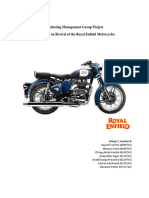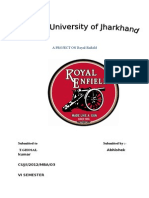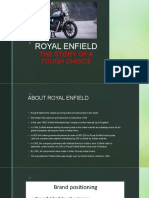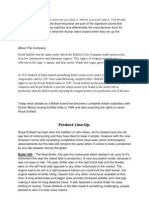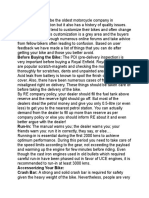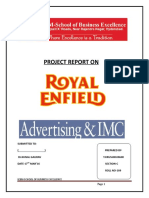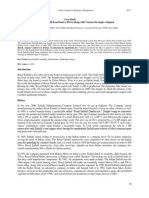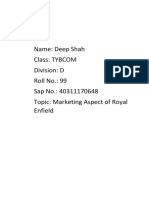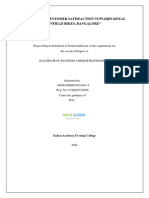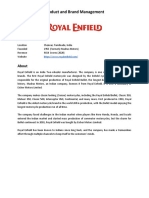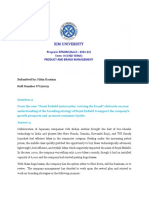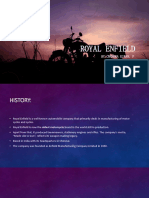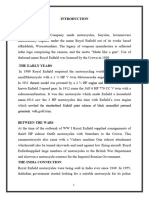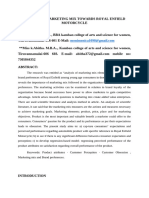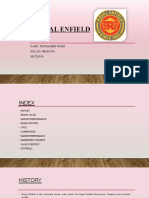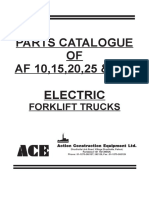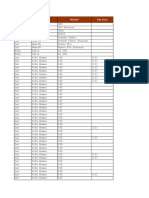Hypothesis of Royal Enfield
Hypothesis of Royal Enfield
Uploaded by
mrchavan143Copyright:
Available Formats
Hypothesis of Royal Enfield
Hypothesis of Royal Enfield
Uploaded by
mrchavan143Original Description:
Copyright
Available Formats
Share this document
Did you find this document useful?
Is this content inappropriate?
Copyright:
Available Formats
Hypothesis of Royal Enfield
Hypothesis of Royal Enfield
Uploaded by
mrchavan143Copyright:
Available Formats
Hypothesis: CHALLENGES FOR EICHER MOTORS WHILE REVIVING BULLETS Modernising the bikes without taking away their
unique identity Summary: Executive Summary: Senior managers at Eicher Motorsfaced a tough choice. They had been given one final chance to revive the loss making Royal Enfield their motorcycle division. For that they wanted to modernise the bikes to appeal to a wider customer base. But existing customers wanted their Bullets just the way they had always been. By modernising, Royal Enfield risked losing traditional fans without possibly gaining any new customers.. The year 2000 could have been decisive. That was when the board of directors at Eicher Motors decided to either shut down or sell off Royal Enfield- the company's Chennai-based motorcycle division, which manufactured the iconic Bullet motorbikes. For all its reputation, the sales of the bike was down to 2,000 units a month against theplant's installed capacity of 6,000; losses had been mounting for years, there were also frequent complaints about them - of engine seizures, snapping of the accelerator or clutch cables, electrical failures and oil leakages. Many found them too heavy, difficult to maintain, with the gear lever inconveniently positionedand a daunting kick-start. Siddhartha Lal, a third generation member of the Delhi-based Lal family, promoters of the Eicher group of companies. Lal, then 26, was an unabashed Bullet fan Lal felt Royal Enfield could still be saved. Thebike had its The petrol tank's design was left largely untouched as it contributes to the bike's sturdy, vintage look After much testing, the silencer was extended to capture, to the extent possible, the throb of the old engine Diehard fans opposed shifting the gearlever to the left side of the bike, but the company went ahead anyway reputation, a cult following, an instantly recognizable build, and aspirational value. Changes had to be made to keep up with the times and make the bike more acceptable, and therein lay the problem Ravichandran had earlier worked with both TVS Motor and Bajaj auto The mistaken notions of prospective customers had to be addressed, and any reservations about Bullet and Thunderbird, which was launched in 2002, removed. since long time users were dead opposed to the change A modern aluminium engine would eliminate these problems, but it would lack the old engine's pronounced vibrations and beat - which Royal Enfield customers loved. Laws of physics made it impossible to replicate these with the new engine. There are many global examples of auto companies going under following a radical change in the engine of their products. The new aluminium engine improved the bikes' performance, but could not recapture fully the beat of the old one original. The new engine had 30 per cent fewer parts and produced 30 per cent more power than the old, with better fuel efficiency. By 2010, all Royal Enfield models had begun to use the new engine. Two other problems needed to be addressed: the quality of some of the components Royal Enfield bikes were using, and the sales experience. To tackle the first, shop floor processes were fine tuned, while suppliers were exhorted
to improve quality levels. Royal Enfield also embarked on a large scale internal exercise to tone up performance Slowly, the tide turned. Engine related problems and oil leakages in Royal Enfield products almost disappeared. By 2008 dealers were reporting lower workloads. Warranty claims fell sharply too. Malfunctioning of the sprag clutch, on which the electric starter depends, declined, for instance, from five per cent in 2005/06 to 0.2 per cent in 2010/11 To improve sales experience new company-owned showrooms were launched and dealerships expanded. In October 2008, Royal Enfield launched in Germany its newly designed 500cc Classic model - inspired by J2, a 1950 model Bullet - with the new engine. It was a success, admired for its performance and fuel economy. Emboldened, Lal launched it in India in November 2009 initially as a 350 cc bike, priced at Rs 1.20 lakh. This proved a hit too. "Now, our capacity utilisation is 100 per cent. Yet there is a six months waiting period Analysis: Royal Enfield also began conducting marquee rides to promote leisure biking. "Such steps removed the fears about our products' reliability some customers may have had," says Venki Padmanabhan, who succeeded Ravichandran as CEO earlier this year after Ravichandran was elevated to the board of Eicher Motors. To improve sales experience new company-owned showrooms were launched and dealerships expanded. Recomandation: Blue Ocean Strategy will help Royal Enfield to improve market share and increase sales volume and the profit margin.
You might also like
- 2009-2012 Skoda Yeti - 2011 Electrical Wiring Diagrams EWD - 3Document959 pages2009-2012 Skoda Yeti - 2011 Electrical Wiring Diagrams EWD - 3Vasile Silvio100% (2)
- Chevrolet Small-Block Parts Interchange Manual - Revised EditionFrom EverandChevrolet Small-Block Parts Interchange Manual - Revised EditionRating: 5 out of 5 stars5/5 (31)
- Mk5 VW Golf Instrument Cluster Workshop Manual PDFDocument10 pagesMk5 VW Golf Instrument Cluster Workshop Manual PDFAlex Taylor0% (1)
- Royal Enfield: Revival of A Cult Brand: Answer The Following QuestionsDocument1 pageRoyal Enfield: Revival of A Cult Brand: Answer The Following Questionssai priya tirumalasettyNo ratings yet
- Royal Enfield Casestudy - Group 7 - Section BDocument19 pagesRoyal Enfield Casestudy - Group 7 - Section BChirag Kavdia100% (1)
- Royal Enfield IndiaDocument20 pagesRoyal Enfield IndiaKapil Manchanda100% (4)
- 1997 Cadillac Deville Owners ManualDocument386 pages1997 Cadillac Deville Owners ManualmacvsogchingaNo ratings yet
- Turbo Application CatalogueDocument36 pagesTurbo Application Catalogueharneak90% (10)
- BT 50 2012Document269 pagesBT 50 2012Phạm An Bình100% (5)
- F15 Coding Guide - Coding ListDocument3 pagesF15 Coding Guide - Coding ListOctavian D. BobicNo ratings yet
- Senior Managers at Eicher Motors Faced A Tough ChoiceDocument3 pagesSenior Managers at Eicher Motors Faced A Tough ChoiceDitty ThomasNo ratings yet
- Case Study Enfield BikesDocument5 pagesCase Study Enfield BikesUmme Fardina Adil0% (2)
- Biting The BulletDocument5 pagesBiting The BulletSunetra SamantaNo ratings yet
- Case Study Enfield Bikes PDFDocument5 pagesCase Study Enfield Bikes PDFPoornima HegdeNo ratings yet
- Royal Enfield RechargedDocument14 pagesRoyal Enfield RechargedHuseni13100% (1)
- A PROJECT ON Royal EnfieldDocument18 pagesA PROJECT ON Royal EnfieldAbhishek Mahto100% (3)
- Royal Enfield - The Story of A ToughDocument12 pagesRoyal Enfield - The Story of A ToughRenju Pillai100% (1)
- Case Study Sol1Document3 pagesCase Study Sol1vishal sinhaNo ratings yet
- Product Line-Up.: Bullet 350Document6 pagesProduct Line-Up.: Bullet 350Anuth SiddharthNo ratings yet
- Project Report On BulletDocument27 pagesProject Report On Bulletsanjeev bhagatNo ratings yet
- Before Buying The Bike: The PDI (Pre-Delivery Inspection) IsDocument21 pagesBefore Buying The Bike: The PDI (Pre-Delivery Inspection) IsvijayakumarvarmaNo ratings yet
- Royal Enfield Presentation 1Document10 pagesRoyal Enfield Presentation 1Sanju SjNo ratings yet
- Case Study On Royal Enfield: Presented By: Panduranga G JDocument31 pagesCase Study On Royal Enfield: Presented By: Panduranga G JLïkïth RäjNo ratings yet
- Wa0022.Document22 pagesWa0022.sv21mmb0a67No ratings yet
- Case Study On KiaDocument7 pagesCase Study On KiaMuhammed hazimNo ratings yet
- Brand Analysis of Royal EnfieldDocument11 pagesBrand Analysis of Royal EnfieldAbhinav Dattatraya Kadam100% (1)
- Karthick Reprot 2Document37 pagesKarthick Reprot 2praveen100% (1)
- ROYAL ENFIELD - Abhishek - POID AssignmentDocument3 pagesROYAL ENFIELD - Abhishek - POID Assignmentabhishek pattanayakNo ratings yet
- Project Report On: Icbm-School of Business ExcellenceDocument30 pagesProject Report On: Icbm-School of Business Excellencegaurav sharmaNo ratings yet
- Royal Enfield PDFDocument4 pagesRoyal Enfield PDFkowshikNo ratings yet
- Case Study Journey of Royal Enfield From Dusk To Down Along With Various Strategies AdoptedDocument4 pagesCase Study Journey of Royal Enfield From Dusk To Down Along With Various Strategies AdoptedDileep RaghavanNo ratings yet
- Motors in India To Form 'Enfield India' To Assemble, Under License, The 350 CC RoyalDocument4 pagesMotors in India To Form 'Enfield India' To Assemble, Under License, The 350 CC RoyalSangeeth SudhakaranNo ratings yet
- ProjectDocument48 pagesProjectE01202114-MUHAMMED ISMAIL K BBA CANo ratings yet
- Two Wheeler Industry in IndiaDocument7 pagesTwo Wheeler Industry in IndiaPrateek M Jois0% (2)
- Name: Deep Shah Class: TYBCOM Division: D Roll No.: 99 Sap No.: 40311170648 Topic: Marketing Aspect of Royal EnfieldDocument6 pagesName: Deep Shah Class: TYBCOM Division: D Roll No.: 99 Sap No.: 40311170648 Topic: Marketing Aspect of Royal EnfieldDeep ShahNo ratings yet
- Mechanical PresentationDocument12 pagesMechanical Presentationpetmalusiako123No ratings yet
- Royal EnfieldDocument18 pagesRoyal EnfieldNarahari KrishnaNo ratings yet
- Royal Enfield Launches Make-It-Yours' - A Unique Motorcycle Personalization InitiativeDocument2 pagesRoyal Enfield Launches Make-It-Yours' - A Unique Motorcycle Personalization InitiativePruthviraj DhinganiNo ratings yet
- ARYAN JAIN Project 2Document68 pagesARYAN JAIN Project 2Aryan JainNo ratings yet
- Royal Enfield Market PositioningDocument7 pagesRoyal Enfield Market PositioningApoorv Agrawal67% (3)
- Rejuvinating A Declining MarketDocument3 pagesRejuvinating A Declining MarketNitin KarnkaleNo ratings yet
- Rayan ADocument43 pagesRayan ABlack worldNo ratings yet
- Chapter - I: Yamaha GladiatorDocument54 pagesChapter - I: Yamaha GladiatorHemanth KumarNo ratings yet
- ROYAL ENFEILD ProjectDocument54 pagesROYAL ENFEILD ProjectShivakumar Panshetty100% (1)
- Product and Brand Management: DetailsDocument2 pagesProduct and Brand Management: Detailsabhilash191100% (1)
- MM REPORT Royal EnfieldDocument8 pagesMM REPORT Royal EnfieldLeon VargheseNo ratings yet
- Essayfirstdraftfixed 1111 BrandanburkhartDocument3 pagesEssayfirstdraftfixed 1111 Brandanburkhartapi-302846668No ratings yet
- Submitted By: Nitin Gautam Roll Number UV21009Document4 pagesSubmitted By: Nitin Gautam Roll Number UV21009debashreeta swainNo ratings yet
- Royal Enfield: by Chandra Kiran. PDocument20 pagesRoyal Enfield: by Chandra Kiran. Pchandra kiran100% (1)
- Siddharth LalDocument6 pagesSiddharth LalSiddhantNo ratings yet
- Re Full ProjectDocument56 pagesRe Full ProjectMohammed Abdul Kader KNo ratings yet
- Royal EnfieldDocument2 pagesRoyal EnfieldGopinath GovindarajNo ratings yet
- PAPERImpactof Ratio Analysison Financial Performancein Royal Enfield Bhavani Motors BidarDocument17 pagesPAPERImpactof Ratio Analysison Financial Performancein Royal Enfield Bhavani Motors BidaroykcaNo ratings yet
- M.monika Paper PublishDocument13 pagesM.monika Paper PublishmonikaNo ratings yet
- Royal Enfield: Name: Prathamesh Pawar ROLLNO-BBA019198 Section BDocument17 pagesRoyal Enfield: Name: Prathamesh Pawar ROLLNO-BBA019198 Section BDonAld SuR100% (1)
- Royal Enfield Project Tamil PDFDocument70 pagesRoyal Enfield Project Tamil PDFJ Robin J Robin100% (1)
- Baldor Motor PDFDocument55 pagesBaldor Motor PDFWonbae ChoiNo ratings yet
- Honda: Honda CBR1000RR For IndiaDocument5 pagesHonda: Honda CBR1000RR For IndiaAbhishek TiwariNo ratings yet
- Study of Consumer Perception Towards Yamaha Motor Bike: Submitted By: Nitish Singh SEM V (2018-2019)Document11 pagesStudy of Consumer Perception Towards Yamaha Motor Bike: Submitted By: Nitish Singh SEM V (2018-2019)Chandu SutharNo ratings yet
- Bajaj Auto LTD: Two Brand Strategic AnalysisDocument29 pagesBajaj Auto LTD: Two Brand Strategic AnalysisniravNo ratings yet
- Kia Motors: P.Ramesh 180079026Document12 pagesKia Motors: P.Ramesh 180079026Ramesh PiratlaNo ratings yet
- Royal EnfieldDocument19 pagesRoyal EnfieldAkila GauthamiNo ratings yet
- Royal EnfieldDocument24 pagesRoyal EnfieldAbhimanue Carefully Careless100% (1)
- Fact FofeitDocument34 pagesFact Fofeitmrchavan143No ratings yet
- Sunshine Resort: Live in Real NatureDocument36 pagesSunshine Resort: Live in Real Naturemrchavan143No ratings yet
- Acquisition: of Bank of Rajasthan by ICICI BankDocument12 pagesAcquisition: of Bank of Rajasthan by ICICI Bankmrchavan143No ratings yet
- Maruti Suzuki's Manesar Plant Faces Lockout Car Industry Braces For SlumpDocument2 pagesMaruti Suzuki's Manesar Plant Faces Lockout Car Industry Braces For Slumpmrchavan143No ratings yet
- Group Members: Jayshree Varsha Melanie Abhishek Priyanka Rekha HardikDocument27 pagesGroup Members: Jayshree Varsha Melanie Abhishek Priyanka Rekha Hardikmrchavan143No ratings yet
- SEO (Disambiguation) : Internet MarketingDocument8 pagesSEO (Disambiguation) : Internet Marketingmrchavan143No ratings yet
- Unique Identity ProjectDocument17 pagesUnique Identity Projectmrchavan143No ratings yet
- Impact of Information Technology On Business: Presented By: Samrudhi GadveDocument11 pagesImpact of Information Technology On Business: Presented By: Samrudhi Gadvemrchavan143No ratings yet
- Executive Summary of KraftDocument4 pagesExecutive Summary of Kraftmrchavan143No ratings yet
- Khidki VadaDocument2 pagesKhidki Vadamrchavan143No ratings yet
- Management and Its EvolutionDocument14 pagesManagement and Its Evolutionmrchavan143No ratings yet
- Law of ContractsDocument102 pagesLaw of Contractsrajjuneja100% (5)
- TQM EvolutionDocument69 pagesTQM EvolutionVijayakumarNo ratings yet
- Rough MKTNG Insrnce PRCT FinalDocument68 pagesRough MKTNG Insrnce PRCT Finalmrchavan143No ratings yet
- 600Lt Coupe: United StatesDocument6 pages600Lt Coupe: United StatesarstjunkNo ratings yet
- Autos de Planta: Motores Alemanes de Tlalpan, Sa de CV Trafico Miramontes Coapa Tepepan T. SantiagoDocument16 pagesAutos de Planta: Motores Alemanes de Tlalpan, Sa de CV Trafico Miramontes Coapa Tepepan T. SantiagoAlfonso CruzNo ratings yet
- Assembly 1: Covers: Service ManualDocument11 pagesAssembly 1: Covers: Service ManualdatajerzyNo ratings yet
- RicohDocument7 pagesRicohخالد ابوسريعNo ratings yet
- Diagnosis System: Supplemental Restraint System - Airbag SystemDocument9 pagesDiagnosis System: Supplemental Restraint System - Airbag SystemMaiChiVuNo ratings yet
- Parts Cat. Af 15e, 20e, 25e&30eDocument96 pagesParts Cat. Af 15e, 20e, 25e&30emachinery and plantsNo ratings yet
- Typical Weld-On 4-Link: Installation InstructionsDocument3 pagesTypical Weld-On 4-Link: Installation InstructionsHarry LarryNo ratings yet
- Mech CVTDocument15 pagesMech CVTOmar AhmedNo ratings yet
- BATISTA Produtos NovosDocument3 pagesBATISTA Produtos NovosTruck Center ModeloNo ratings yet
- Indian Railways, DLW, Welcomes All of YouDocument17 pagesIndian Railways, DLW, Welcomes All of YouAkash Singh tanwarNo ratings yet
- Towing The Machine (SEBU8751)Document4 pagesTowing The Machine (SEBU8751)Anderson Oliveira SilvaNo ratings yet
- Contact Us - Ford VehiclesDocument5 pagesContact Us - Ford VehiclesFasik ShemelisNo ratings yet
- 2004 Nissan Armada 10Document48 pages2004 Nissan Armada 10Raciel Mendoza100% (1)
- Hydraulic System Veth-Compact-Jet Thruster (11 KW / 100 Ltrs. Steering Power Pack)Document1 pageHydraulic System Veth-Compact-Jet Thruster (11 KW / 100 Ltrs. Steering Power Pack)Costel Ava ConstantinNo ratings yet
- CG04FB7945 - DetailedReport - 5 - 21 - 2020 1 - 16 - 58 PMDocument1 pageCG04FB7945 - DetailedReport - 5 - 21 - 2020 1 - 16 - 58 PMSHOAIB MEMONNo ratings yet
- TESLA SWOT Analysis (Harvard) : June 2018Document4 pagesTESLA SWOT Analysis (Harvard) : June 2018Luis PavezNo ratings yet
- Mercedes-Benz Vito-Van-CrewCab W639-I Specifications 201001Document7 pagesMercedes-Benz Vito-Van-CrewCab W639-I Specifications 201001Ikm KmNo ratings yet
- Hepolite - Japanese - Omega Pistons: British Only Motorcycles and Parts, IncDocument22 pagesHepolite - Japanese - Omega Pistons: British Only Motorcycles and Parts, IncRZDNo ratings yet
- Tabela de Lubrificantes para Caminh Es DieselDocument1 pageTabela de Lubrificantes para Caminh Es DieselClevio FerreiraNo ratings yet
- Tire Wheel CalculatorDocument4 pagesTire Wheel CalculatorSelvin Pérez HerrarteNo ratings yet
- Kess v2 Obd2 Tuning Kit Vehicle ListDocument368 pagesKess v2 Obd2 Tuning Kit Vehicle ListAnonymous k8IQdViNo ratings yet
- Track Carrier Roller: D6N Track-Type Tractor Power TrainDocument2 pagesTrack Carrier Roller: D6N Track-Type Tractor Power TrainAlex FreitasNo ratings yet
- New Features - c59 Transmission PDFDocument2 pagesNew Features - c59 Transmission PDFIvan Torres VillalobosNo ratings yet
- Computer Data Lines f150Document2 pagesComputer Data Lines f150Rogelio ArenasNo ratings yet
- Register Induksi AgustusDocument37 pagesRegister Induksi AgustusSuhendri Candra KarnoNo ratings yet





